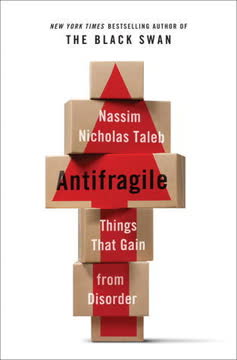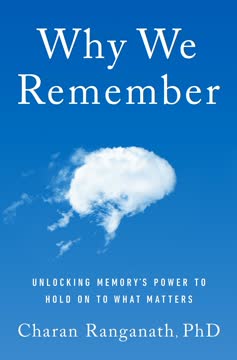Key Takeaways
1. Our Ancestral Past Shaped Our Authentic Needs.
We are essentially a 2.0-version human in the 10.0 world we have created.
Mismatch with modern life. For 99% of human history, our ancestors were hunter-gatherers, living nomadic lives in small, tightly-knit groups, constantly moving, eating natural foods, and facing immediate, not chronic, stress. This environment forged our basic physiology and needs. Our bodies and minds are adapted to this ancient world.
Rapid, unnatural change. The Industrial Revolution (last 10 generations) and the digital age have drastically altered how we live, work, eat, and interact. This speed of change far outpaces our biological evolution. We now live sedentary lives, eat processed foods, experience chronic stress, and are often isolated.
Authentic needs persist. Despite modern conveniences, our fundamental needs for health and well-being remain rooted in our ancestral past. Ignoring these "authentic needs" leads to maladaptation and contributes to modern chronic diseases. Understanding our history is key to understanding what we truly need to thrive today.
2. How We Age Is Primarily Determined by Lifestyle.
How we age is mostly up to us, and that conclusion rocked our stereotypes of aging to the very core.
Beyond genes and luck. The groundbreaking MacArthur Foundation Study on Successful Aging debunked the myth that aging outcomes are primarily dictated by genetics or chance. Their findings revealed that lifestyle choices account for 70% of the physical difference and 50% of the intellectual difference between those who age "usually" and those who age successfully.
Personal control empowers. This research shifts the focus from fatalism to personal agency. We are not passive recipients of aging; we are active participants who can significantly influence our trajectory. This knowledge empowers individuals to take responsibility for their aging experience.
Accountability follows knowledge. Knowing that lifestyle is the major determinant means we can no longer solely blame external factors for poor aging outcomes. This brings accountability, challenging us to make informed choices about our daily habits.
3. Successful Aging Means High Function, Low Risk, and Active Engagement.
Compression of morbidity essentially means that the time we are sick at the end of our life is short...
Defining successful aging. The MacArthur Study defined successful aging by three key characteristics: maintaining high mental and physical function, having a low risk of disease and disease-related disability, and being actively engaged in life. This is the "high road" to aging.
Live long, die short. Achieving these characteristics leads to compression of morbidity. Instead of a long period of decline associated with chronic illness ("usual" aging), successful aging involves maintaining vitality and independence for as long as possible, resulting in a shorter period of illness at the very end of life, like an autumn leaf falling quickly.
A choice in trajectory. We have a choice between the "usual" aging curve (early decline, long morbidity) and the successful aging curve (delayed decline, compressed morbidity). Lifestyle choices directly influence which path we take, impacting not just longevity but the quality of those later years.
4. Change Is Constant; Small Steps Are Key to Self-Improvement.
Kaizen is about small changes, easily achievable goals that are so small they do not trigger the amygdala to go into alert mode.
Life equals change. Change is an inherent part of life, yet humans often resist it, fearing the unknown. This resistance is deeply wired in our brains, triggering a fear response (amygdala activation) that hinders rational thought and action when faced with significant change.
Innovation vs. Kaizen. Our culture often values "innovation" – drastic, rapid change – which frequently triggers this fear response, leading to failure in personal change efforts (like New Year's resolutions). Kaizen, a Japanese technique, advocates for small, incremental changes that are so tiny they bypass the fear mechanism.
Building momentum fearlessly. By asking small questions, using mind sculpture (imagining the action), and taking tiny steps, we build new neural pathways without triggering fear. This allows us to make progress, build confidence, and gradually achieve significant lifestyle changes over time, one small, non-threatening step at a time.
5. "Use It or Lose It" Applies to Physical, Mental, and Social Abilities.
What did your grandmother tell you? Use it or lose it.
Disuse leads to decline. Just as astronauts lose muscle mass in zero gravity or a rusty bicycle becomes unusable, our physical, mental, and social abilities decline when not regularly used. This isn't just about aging; it's a fundamental principle of human physiology and cognition.
Modern life encourages disuse. Technology and convenience have systematically removed the need to use many of our faculties daily.
- Physical: Elevators, cars, sedentary jobs reduce movement.
- Mental: Calculators, GPS, internet search reduce memory and problem-solving demands.
- Social: Digital communication reduces face-to-face interaction skills.
Active engagement builds resilience. To counteract this, we must deliberately use and challenge our abilities across all dimensions. This active engagement maintains function and builds resilience, making us better equipped to handle life's inevitable challenges and preventing premature decline.
6. Movement Is Fundamental to Health and Longevity.
Movement is a medicine for creating change in a person’s physical, emotional, and mental states.
Essential for human physiology. Our bodies evolved requiring constant physical activity for survival. This need is hardwired. Modern sedentary lifestyles are a major mismatch, contributing significantly to chronic diseases.
Profound health benefits. Regular movement, even moderate walking, offers astonishing benefits:
- Reduces risk of heart disease, stroke, cancer, diabetes, osteoporosis.
- Improves mood, sleep, and cognitive function.
- Increases energy and resilience.
Reintegrating movement. Instead of viewing movement as scheduled "workouts," we should reintegrate it into daily life, like our ancestors did. Simple changes, like walking more, taking stairs, or incorporating movement into hobbies, are highly effective and accessible to most people, regardless of age or fitness level.
7. Challenging Your Brain Fosters Resilience.
Neuroplasticity "refers to the lifelong capacity of the brain to change and rewire itself in response to the stimulation of learning and experience."
The dynamic brain. Contrary to older beliefs, the adult brain is not static but dynamic, capable of changing, rewiring (neuroplasticity), and even generating new cells (neurogenesis) throughout life. We are the architects of our own brains.
Stimulation is key. Learning new things and engaging in mentally challenging activities stimulates brain growth and maintains cognitive function. The Nuns Study showed that a lifestyle of mental activity could protect against the symptoms of Alzheimer's, even when the physical signs of the disease were present in the brain.
Holistic brain health. Optimal brain health depends on a combination of factors:
- Physical activity (increases blood flow and growth factors like BDNF).
- Mental stimulation (learning new skills, challenging routines).
- Stress control (chronic stress damages brain areas like the hippocampus).
- Balanced nutrition (provides necessary fuel and nutrients).
8. Social Connection Is a Powerful Determinant of Health.
It’s better to eat fries with friends, than broccoli alone.
Wired for connection. Humans are fundamentally social creatures, a trait rooted in our evolutionary history where group survival was paramount. This need for connection is deeply embedded in our biology, influencing our emotions and behavior.
Significant health impacts. Research consistently shows a strong link between social connection and health outcomes. Socially isolated individuals are significantly more likely to experience illness and premature death compared to those with strong social ties.
Quality over quantity. While modern technology allows for wide networks, the most beneficial connections are often deep, face-to-face relationships. Nurturing close friendships and being actively engaged in a community provides emotional support, reinforces healthy behaviors, and positively impacts the immune system and stress levels.
9. Lowering Risks Involves Managing Stress and Nutrition.
Most of us will live long enough and well enough to get seriously ill with a stress-related disease.
Lifestyle drives risk. While genetics play a role, a significant majority of chronic diseases and premature deaths are linked to modifiable lifestyle factors like smoking, inactivity, poor diet, and stress. We unintentionally open the door to these threats.
Stress: The Big Uneasy. Our unique human ability to trigger the fight-or-flight response with thoughts creates chronic stress (allostatic load). This constant state of alert wears down the body, compromising the cardiovascular and immune systems and increasing the risk of numerous diseases, from heart attacks to dementia.
Nutrition: Fueling resilience. Our bodies function best on a diet similar to that of our ancestors: primarily fruits, vegetables, nuts, fish, and lean meats, eaten in moderation. Modern diets high in processed foods, simple sugars, and unhealthy fats contribute to obesity and related diseases. Eating right provides the necessary fuel for health and resilience.
10. Rejecting Ageist Expectations Is Crucial for Continued Growth.
How old would you be, if you didn’t know how old you were?
Expectations shape reality. Societal ageism often sets low expectations for older adults, viewing aging as primarily a process of decline. This can become a self-fulfilling prophecy, limiting opportunities for growth and engagement.
Never "act your age". To age successfully in a culture with diminished expectations, one must resist conforming to these stereotypes. This means continuing to learn, try new things, take calculated risks (where the outcome is growth, not just danger), and maintain a sense of curiosity and adventure, regardless of chronological age.
Mindset matters. Research suggests that our bodies tend to align with our expectations of ourselves. Believing in our continued capability and potential for growth can positively influence our physical and cognitive function, helping us to remain vital and engaged.
11. Finding Purpose Is Essential for Well-Being.
Your happiness does not depend upon reaching your goal, but upon setting a goal, and working toward it.
Beyond retirement. After decades of work and raising families, many older adults face a crisis of meaning when traditional roles end. A life solely focused on comfort and recreation, like a cruise ship, often leaves a void. Humans need a "raison d'être," a reason to get out of bed.
Meaningful activity matters. Purpose is found in activities that are personally meaningful, not necessarily those that are paid or recognized by society. This often involves contributing to others or the community, aligning with Erikson's concept of generativity or "grand-generativity" in later life.
Health benefits of purpose. Research shows that having a sense of purpose, particularly through volunteerism or service to others, is linked to lower mortality rates, greater functional ability, and reduced depression. It provides continued engagement and a sense of value at a time when social roles may be changing.
12. Laughter and Positive Outlook Boost Health.
Laughter is the shortest distance between two people.
Physiological benefits. Laughter is more than just an emotional expression; it has measurable positive effects on the body. Studies show that laughter reduces stress hormones, boosts immune function (activating T cells and natural killer cells), and releases endorphins, which relieve pain and improve mood.
A choice for resilience. While life inevitably brings challenges and losses, our response is a choice. A positive outlook and the ability to find humor, even in difficult circumstances, can act as powerful buffers against stress and contribute to resilience, as seen in studies of centenarians.
Enhancing connection. Laughter is a universal human behavior that fosters social bonding and improves the quality of interactions. Choosing to laugh readily not only benefits individual health but also strengthens social ties, which are themselves crucial for successful aging.
Last updated:
Review Summary
Live Long, Die Short receives mixed reviews, with an average rating of 3.74/5. Some praise its positive outlook on aging and practical advice for maintaining physical, mental, and social well-being in later years. Critics argue the book lacks originality, repeating common health advice. Several reviewers appreciate the emphasis on purposeful living post-retirement, while others find it repetitive or overly focused on promoting the author's Masterpiece Living program. The book's holistic approach to aging resonates with many readers, though some question the effectiveness of specific program elements.
Similar Books










Download PDF
Download EPUB
.epub digital book format is ideal for reading ebooks on phones, tablets, and e-readers.




